Fishing Report: Dec. 17, 2021

You can find plenty of hogfish near shore
Over at Hubbard?s Marina, they are seeing plenty of hogfish lately. Around 40-70 feet of water is where they are focused on targeting them, says Captai Dylan Hubbard.
MADEIRA BEACH, Fla. - Every Friday morning, Captain Dylan Hubbard of Hubbard's Marina joins Good Day to fill viewers in on his fishing forecast as we head into the weekend.
Here is his fishing report for December 17, 2021.
Weather impacts on fishing
We are coming up to a full moon Sunday on the backside of a high pressure with a frontal boundary pushing down Monday. This should lead to some pretty active fishing action on the backside of the weekend especially, however, through Saturday too we will see more tidal flow and a moving barometer. That should have the fish excited.
The best fishing this week should be around this weekend. Monday, when the frontal boundary approaches, it will break down to an occluded front and stall a bit before exiting fully Wednesday with a high pressure building back in heavily Thursday.
LINK: FOX 13 weather forecast
These pressure gradients fighting over the area will cause increased surface level winds with the highest winds early to mid-week around Tuesday and Wednesday but will have the fish moving and things stirred up too.
Tuesday seems to be the least favorable weather day. The best days to fish are Friday through Sunday -- with Sunday being the best. Monday will be decent inshore and near shore and, perhaps Thursday, but it’s too early to tell for sure as things can change so rapidly. However, we know for sure this weekend is the time to fish especially Saturday inshore and near shore and Sunday anywhere!
Inshore
We are seeing a pretty active snook bite around the area the past few days. It seems the higher winds finally returning is stirring up our waters just a bit. That’s all it took to wake up the snook a bit more to chew.
The long period of nice weather conditions had the water clear. The snook were extremely leader shy and timid. However, with some strong east winds, some local anglers were able to find the snook really chewing. Also, the big schools of mullet started moving around more and some started to flush out of the back bays to head to the Gulf. This could perhaps be part of the increase in snook action too.
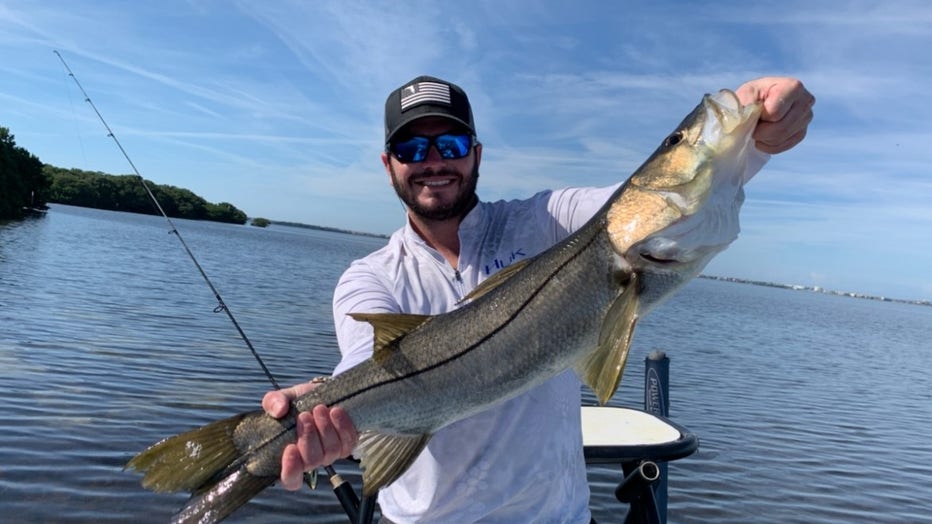
Snook (Credit: Hubbard's Marina)
Finger mullet and smaller silver mullet are great baits if you can get them for snook this time of year. Snook are still hanging around the passes as the bait and mullet are still around, but a majority are back in the back bays and along the flats, oyster bars, mangrove islands, and dock lines.
Residential canals become a better and better area to fish as water temperatures subside. Live shrimp, pinfish, pigfish, and pass crabs all are good options too for snook this time of year live bait-wise. Artificial lures that are working well are the swimbaits, jerk baits, and soft plastics with the currents around those ambush points of structures, points, pockets, or passes where snook stack up to wait for passing baits.
Redfish action has been solid this past week as well. We are seeing them around 2-3 feet of water around local grass flats, oyster bars, and mangrove islands -- most actively during the day.
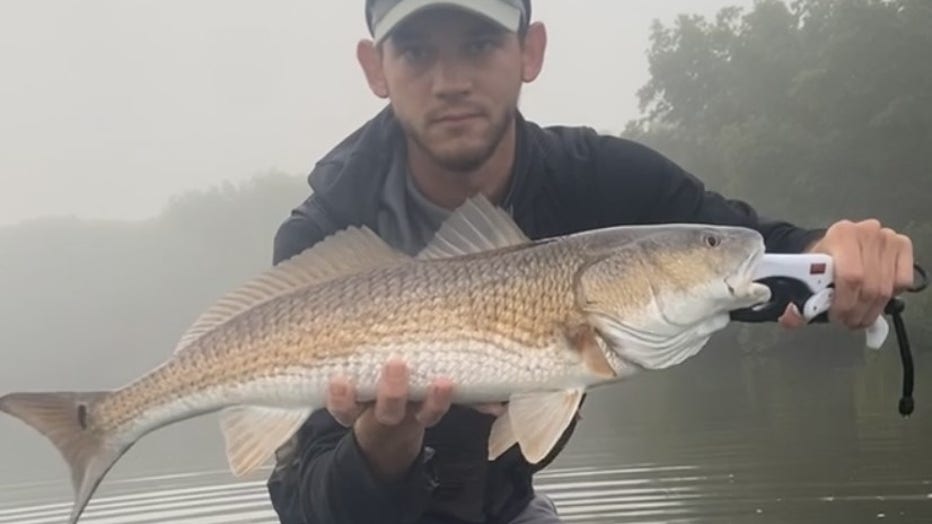
Redfish (Credit: Hubbard's Marina)
At night, you can find them around those dock lights, bridge lights, and other areas where light is congregating bait to structures working the bottom for crustaceans and baitfish. More mullet moving around the area has definitely got the redfish more active. They follow those schools around the flats and shallow areas to pick off the bait.
Trout action this past week has been a little spottier, but you can find pockets of fish around those cuts, potholes, and edges of the flats. Also, residential dock lines and bridges near the flats will hold trout waiting for baits to pass by. Slow-moving soft plastics working with the currents are a great way to net passing trout.
Sheepshead are biting well around the area’s structures like rock piles, bridges, dock lines, seawalls, and everything in between. These guys are definitely getting more concentrated and aggressive. This upcoming week’s adverse weather should help further solidify their concentrations around these local structures of the bays and passes.
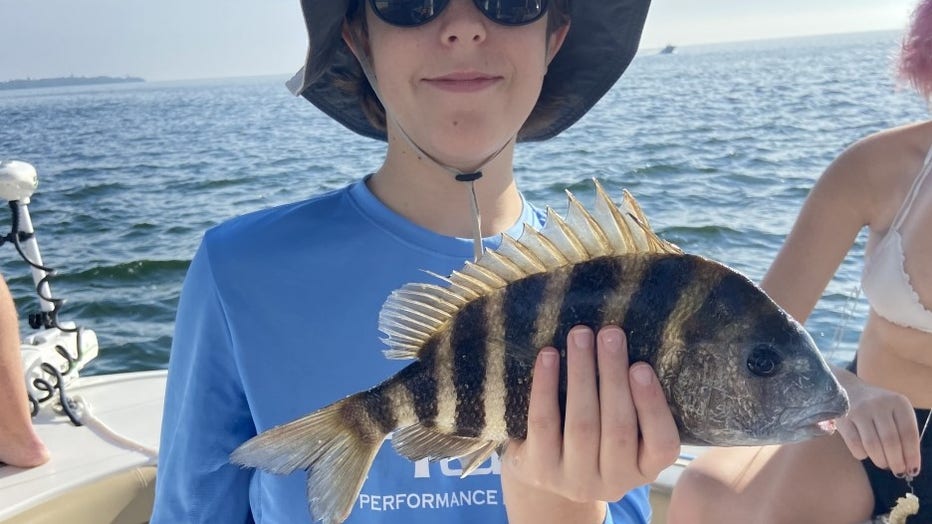
Sheepshead (Credit: Hubbard's Marina)
Lighter tackle, small pieces of shrimp, clam, oysters, even fiddler crabs, barnacles, or sand fleas are great options to target this fun to catch great eating fish. However, you need minimal weight and a small strong hook to get them -- plus being fast and feeling the bite is key as well.
The pompano action around the area is going well too. You might pick up some flounder while targeting them. Drifting sandy passes or casting a pompano jig around those bridges leading to sandy areas of moving water are great places to look for pompano. The Fort De Soto area, Honeymoon Island area, Anna Maria, Pass-A-Grille, Blind’s Pass, and even John’s Pass are great areas to look for pompano, but we see them further up in the bay too around the Dick Misner Bridge, Courtney Campbell Causeway, and other areas too.
Tripletail are still around the area but have been a little more spread out and harder to find. Plus, it was difficult to find the keeper-sized fish, and now it seems tougher and tougher as they spread out and thinned out with this recent warm snap. Hopefully, they will return behind this little temperature break coming up this week.
Near shore
Right now at Hubbard’s Marina we are focused on and seeing plenty of these hogfish lately. Around 40-70 feet of water is where we are focused on targeting these guys on small ledges, large areas of hard bottom, and rock piles.
Even shell or less dense areas of the bottom with just a little fuzz on the machine will hold these guys as they scavenge during the day looking for crustaceans around sea fans and other bottom structures. We are anchored up, fishing these areas with live shrimp, and doing our best to capitalize on the increased hogfish bite.
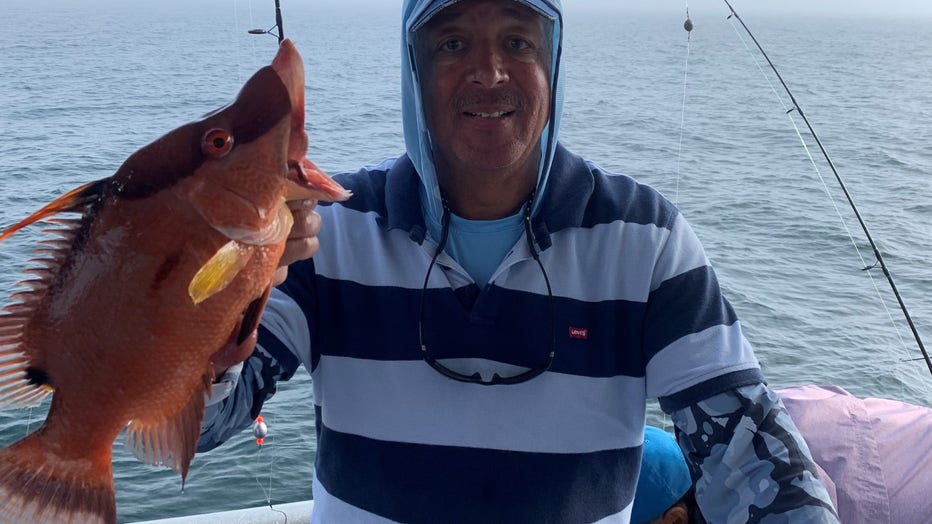
Hogfish (Credit: Hubbard's Marina)
Using lighter tackle around 30lb floro with about 3-4ot hooks and live shrimp is the most popular approach for these fish. You definitely need some patience and resilience because hogfish can be the great equalizer. Even if you’re doing it all right, one day you could have the hogfish biting something a little different or tackle you wouldn’t ever imagine would work for a hogfish like a steel leader, big chicken rig, or even heavier tackle and a big lead. Other days you could be catching them, but you’re only getting the small ones while others are landing keepers.
They definitely are a ton of fun but there’s no solid way to guarantee you’re going to be the one to catch them consistently and often on the boat with other anglers. When targeting hogfish, the first-time angler has just as much a chance as the experienced angler even if they aren’t completely tackled down and really working for them.
Essentially, these fish put the phrase ‘that’s why they call it fishing, not catching’ into a whole new perspective. Don’t get me wrong, experience, the right rod and reel, the right tackle, and the right bait definitely help but some days nearly anything would work if you’re in the area where the hogfish are present, and they are hungry.
Gag groupers are still biting near shore, but more prolific in the deeper near shore waters past around 50-70 feet of water and we aren’t targeting that area as much as we stay shallower for hogfish that are biting better. Plus, the lane snapper is still closed. Nearly a year after the Gulf Council voted to increase the catch levels, NOAA still is unable to enact that rule change. Luckily, on January 1, lanes will re-open regardless of whether or not the agency can get anything accomplished.
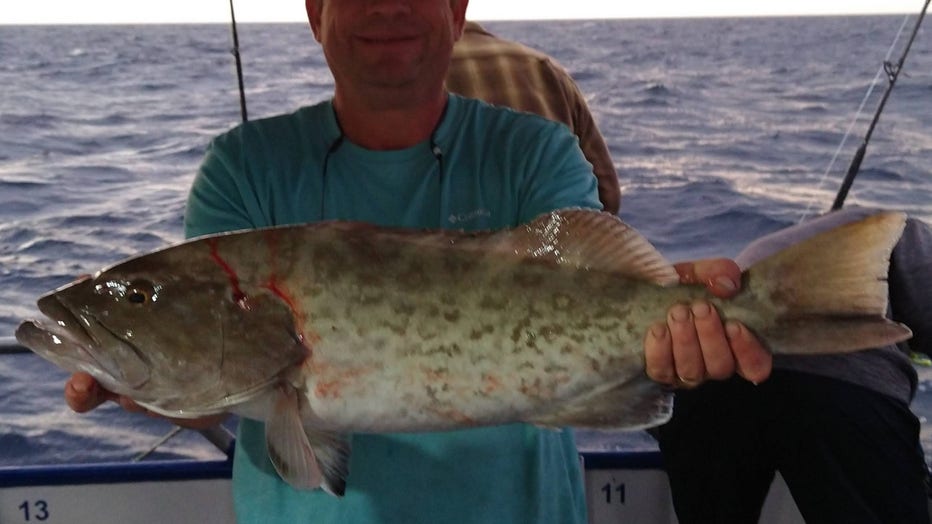
Gag grouper (Credit: Hubbard's Marina)
With the lanes closed and the gag bite not super stellar near shore, we are staying shallower where hogfish are biting best, and we avoid the issues of having to discard lane snapper that don’t seem to do well upon release. We hate to see fish float off and we work hard to avoid that with venting tools or descending devices but lane snapper are so prolific and seem super affected by barotrauma issues. It’s easier to just avoid them until we can put them in the box instead of wasting them with discard mortality numbers higher than we can stomach.
You can still see some gag grouper in shallower in that 40-70 feet range on live pinfish, pigfish, squirrelfish, and lizardfish. However, they are super leader shy and around 50-60lb test with about a 6ot hook is what you want in that depth range to get one to bite. Even as light as 40lb is needed sometimes but hooking into an aggressive gag in shallow on light tackle is a challenge to land.
Kingfish are around near shore this past week once again. We saw a handful of kingfish caught trolling in and out on our trips mostly on simple planners and spoons around 30-50 feet of water around those crab trap buoys.
They are cruising areas of the hard bottom where the bait is present, and those crab traps are always on the hard bottom. Their buoys and lines to the trap become great areas to hold the bait the kingfish cruise around looking for. Often the crab trap lines are a great area to work when looking for the kingfish if you can’t find the birds working a big bait school.
Offshore
The gag grouper bite is still solid offshore. We just got back from a mid-week, 39-hour trip and we found the gags biting well again for us a bit deeper than we found them back in early December.
They are for sure moving around the area right now in large concentrations. This past trip we saw a soft gag grouper bite for most of it ‘til we found that depth and area that they were concentrated. Then nearly 20 keeper gags were a one-stop and another stop with a few more all in the same depth and area. We are looking forward to continuing to target that depth and starting there next week on another 39-hour adventure.

Gag grouper (Credit: Hubbard's Marina)
Anywhere from 120-200 feet is a good starting place to look for these guys, and once you find them concentrated in a depth zone, continue to work that area and you will find them in good numbers. Big live baits still working best with around 60lb test for the best bites but 80lb test to be safe.
We caught a few big dogs this last trip as we were fishing deeper so starting with 80lb test is wise and if the bite is slow you can drop to 60lb. The biggest gags were caught on what we call ‘half-day baits’ where guests do our 5-hour half-day prior to our 39-hour to load up on grey snapper or white grunts, big squirrelfish, lizard fish and other near shore baits to then take offshore for bigger select baits. We also continue to see a solid bite of gags on dead bait too.
Scamp grouper cooperated well for us this past week as we worked deeper. We are seeing some solid scamp lately biting on the live pinfish, dead thread fin, and even the vertical and slow pitch jigs. These guys love to hang out in the deeper water and around those same ledges and potholes that will hold the gags. Once gags close at the end of the year, and we start fishing even deeper for fat red grouper, the BIGGEST scamp comes out to play.
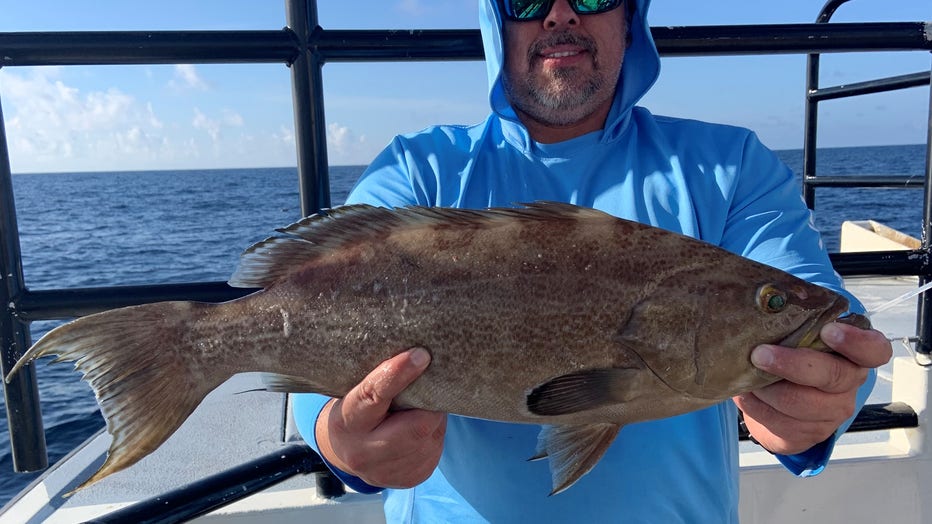
Scamp (Credit: Hubbard's Marina)
Mangrove snapper action is going well for us lately. We have seen a solid mangrove bite the last few trips offshore. Overcast days allow the mangrove bite that we typically see at night to continue strongly through the daytime in low light conditions.
Don't be a fool; bring a venting tool and/or a descending device
It is so important to keep in mind the importance of dead discards and discard mortality when engaged in near shore or offshore fishing. If we can all work together to change the cultural norms near shore and offshore, we can all help to improve our fishery and our fishery access overtime.
How many do you know right now that are all for catching and releasing snook, redfish and trout but will be the first in line to kill a mangrove snapper, gag grouper or red snapper and the attitude completely changes when discussing these offshore species?
Plus, the same person inshore that will hold their breath and wet their hands before handling a breeder snook will go offshore and then cull through 20 red snappers before keeper their two red snapper they deem large enough to fill their two fish bag limits while the other 18 they released will often end up suffering fatal damage if not properly descended or vented?
Please help us to spread the word on the importance of descending or venting your released fish. Descending devices are most easy to use and quick to pick up on their use and are most effective for most anglers. However, an expert and precise angler with proper training and tons of experience can use a venting tool properly with similar outcomes. However, a venting tool requires you to pierce the fish while most descending devices are much less invasive.
While using a venting tool it is imperative you pierce them in the exact right spot, and you do not go but a quarter inch or less in the fish. Most venting tools require you to ‘choke up’ on the tool to prevent over penetration into major organs.
When fishing deep water, especially in the sweltering summer months, please make sure to treat all fish intended to be released like that breeder snook inshore and minimize the time it takes you to get him from the bottom to the boat using heavier proper tackle not an ultra-light spinning reel. Then once on board, minimize the time out of the water. Then use a proper dehooking tool, and then for the love of God, use a descending device or venting tool PROPERLY to ensure that fish has a chance to live another day.
Three things will help ensure the survivability of those fish released offshore.
- Making sure they are brought up quickly and do not expend all their energy in the fight.
- Make sure they are unhooked smoothly, easily, and as quickly as possible.
- Finally, make sure they spend the least amount of time at the surface at negative pressures where barotrauma exponentially increases its effect with each passing second.
Also, keep in mind when the water is warm there is less dissolved oxygen content and the chances of barotrauma increase even more while its effects can be even more deadly.
CHECK OUT THE NEW WEBSITE and marketing campaign to get your own FREE descending device and more information on mitigating barotrauma and barotrauma issues! Do not forget to use the hashtag #ReturnEmRight to help spread the word too on fish you catch and release offshore -> https://returnemright.org/
State survey to improve recreational data and access
It is imperative that you have your gulf reef fish survey endorsement on your fishing license if you are a private recreational angler or diver fishing from a private boat anywhere in Florida who intends to harvest, attempt to harvest or possess one or more of the following reef fish species: mutton snapper, yellowtail snapper, hogfish, red snapper, vermilion snapper, gag grouper, red grouper, black grouper, greater amberjack, lesser amberjack, banded rudderfish, almaco jack, gray triggerfish, Gag grouper, Red grouper, Scamp grouper, Mangrove snapper, Lane snapper, Kingfish, Tuna, or Mahi mahi.
Here is all the information and more on that program and how you can sign up -> https://myfwc.com/fishing/saltwater/recreational/state-reef-fish-survey/
TERMS OF REFERENCE:
INSHORE – from the back bays out to the bridges and including right on the beaches
NEAR SHORE – From the beaches out to 20 miles, or up to 100ft of water
OFFSHORE – from 20 miles or 100ft and beyond
For more fishing reports, photos, videos and more check out Hubbard’s Marina on Facebook, Instagram, YouTube, or Snapchat. Just simply search "HubbardsMarina" and do not forget our family motto, "If you’re too busy to go fishing, you’re just too busy!

